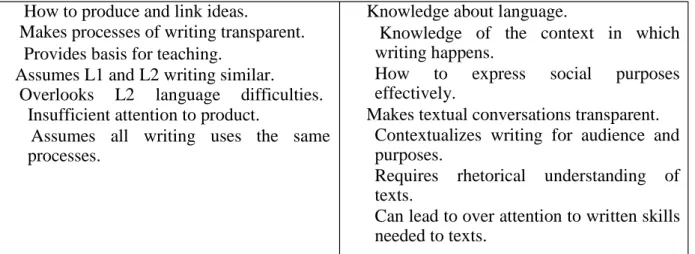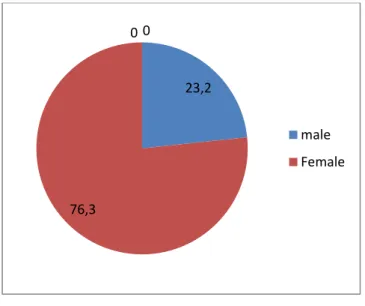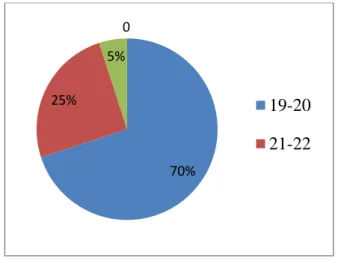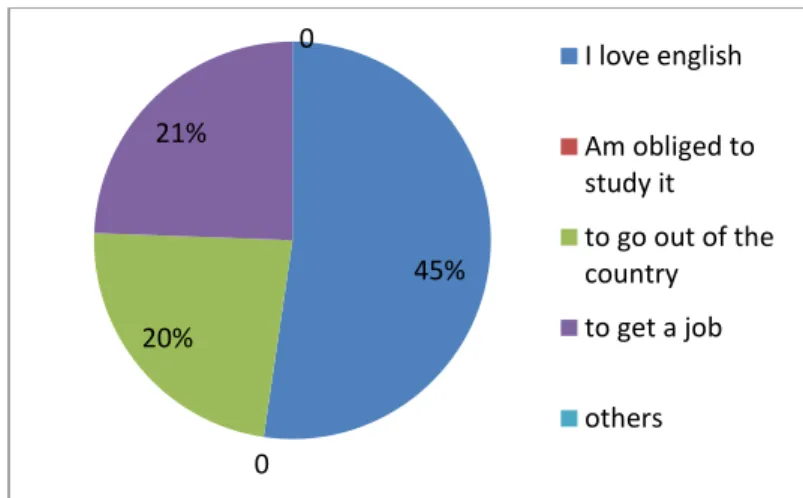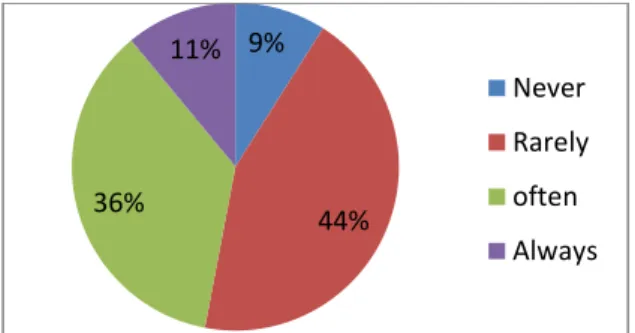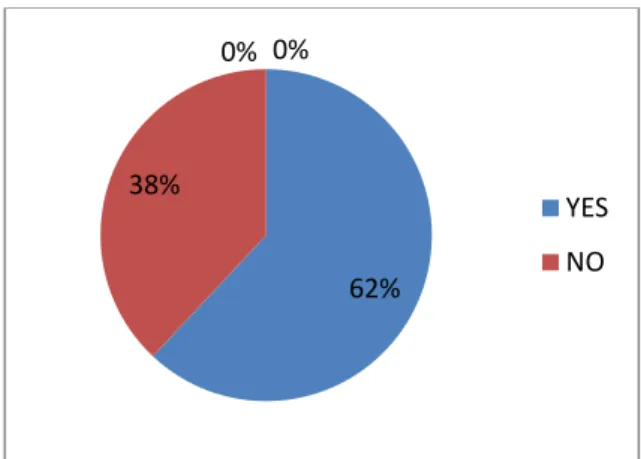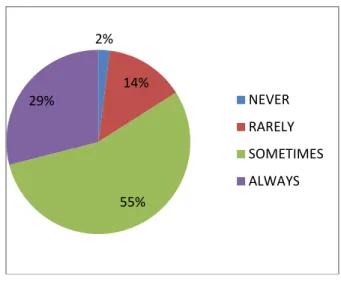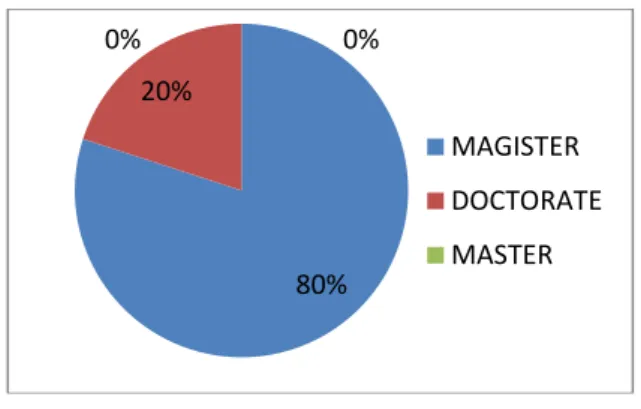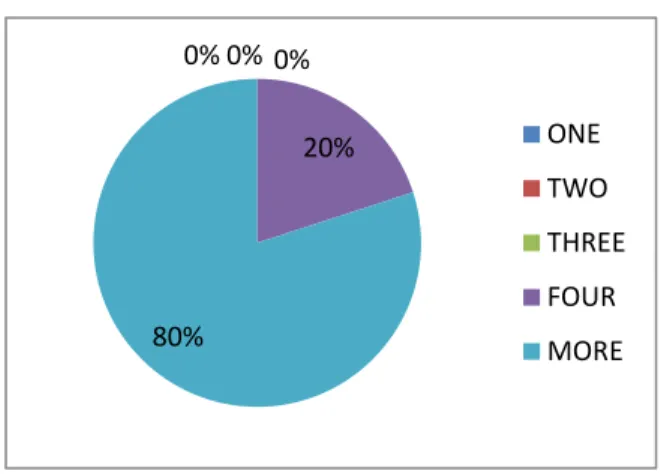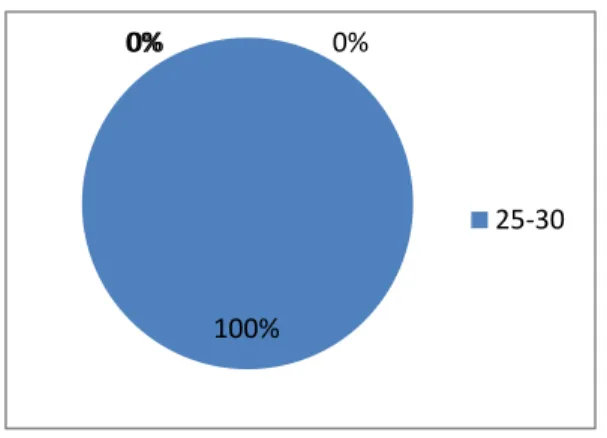Ministry of Higher Education and Scientific Research University 8 Mai 1945 - Guelma
Faculty of Letters and Languages Department of Letters and English Language
ةعماج 8 يام 5491 -ةملاق تاغللاو بادلآا ةيلك ةيزيلجنلاا ةغللاو بادلآا مسق
Exploring the Impact of Teacher’s Scaffolding Techniques on the
Writing Skill in EFL Classrooms Case of Second Year Students at the
Department of English (8 Mai 1945 university, Guelma)
A Dissertation Submitted to the Department of Letters and English Language in Partial Fulfillment of the Requirements for the Degree of Master in Language and Culture
Submitted by: Supervisor:
Ms. Beddiar Yousra Mr. Chettibi Mohammed Walid Ms. Deharna Imen
BOARD OF EXAMINERS
Chairwoman: Mrs. BISKRI Yamina (MAA) University 8 Mai 1945- Guelma Supervisor: Mr. CHETTIBI Mohammed Walid (MAA)University 8 Mai 1945- Guelma
Examiner: Ms. HARIDI Samiya (MAA) University 8 Mai 1945- Guelma September 2020
Dedication
We dedicate this work to all who believe in us
To our beloved parents who are always supporting us may god bless them To our
brothers; “Abdelghafour”, “Adel”, “Aissa”, and “Mohammed Islam”
To our sisters; “Cherifa” and “Randa”
To our teachers throughout our career
To our lovely friends; “Ghada”, “Manel”, “Warda” and “Sara”
Beddiar yousra
Acknowledgment
First of all we thank Allah
We would like to give our grateful thank to our supervisor Mr. Mohammed Walid
Chettibi for his kindness, encouragement and guidance that help us to accomplish this
research.
We would like to thank the examiners Ms. Biskri Yamina and Ms. Haridi Samia
for accepting to read and evaluate this dissertation.
Special thanks to the teachers of written expression module, and second year students
Abstract
The research is conducted to explore the impact of teachers' scaffolding technique
on students' writing skill in EFL classroom. It is hypothesized that teachers and students
suppose that the use of scaffolding techniques may have an impact on the writing skill.
Therefore, the quantitative method is used to collect data, in which two questionnaires
were administered, one on Facebook as Google form for 56 second years students at the
Department of English in 08 Mai 1945 Guelma University, and one was sent via email as a
word document to six (06) teachers of written expression module at the same Department.
The results of both questionnaires indicate that teachers' scaffolding techniques have a
positive impact on students' writing skill. Thus, it is recommended that teachers keep using
these techniques while teaching writing.
List of Figures
Figure1: Learners’ Gender……… 38
Figure2: Learners’ Age……… 39
Figure 3: Number of Years of Study……….. 40
Figure 4: students’ level in learning English………. 40
Figure 5: the aim behind studying English……… 41
Figure 6: students’ level………. 41
Figure 7: students’ level in writing……… 42
Figure 8: evaluation of students’ writing proficiency……….. 42
Figure 9: writing outside the classroom………. 43
Figure 10: practicing writing in other modules………. 43
Figure 11: the way students practice writing………. 44
Figure 12: students’ difficulties in writing……… 44
Figure 13: the students’ difficulties in writing……… 45
Figure14: students’ views about following the steps of writing……… 46
Figure15: students’ views about the most difficult step of writing……….. 47
Figure16: students’ views on the main elements that characterized effective writing.... 47
Figure17: students’ views about teacher’s help……….. 48
Figure 19: students’ views on teacher’s guidance………. 49
Figure20: students’ views about correcting each other’s drafts………. 49
Figure21: teachers’ feedback………. 49
Figure22: The importance of teachers’ feedback……… 50
Figure23: types of scaffolding……… 50
Figure24: students’ views about the importance of teachers’ scaffolding……… 51
Figure25: the result after getting sufficient help from the teacher……… 51
Figure26: teachers’ level……… 53
Figure 27: Number of years teaching English………. 53
Figure 28: Number of years teaching written expression module………. 54
Figure 29: Number of classes of written expression……… 54
Figure 30: the average number of students………. 55
Figure 31: Students’ level in writing……… 55
Figure 32: the importance of written expression in enhancing students’ writing skill56 Figure 33: students’ difficulties in writing……… 57
Figure 34: difficulties of writing that face students……….. 57
Figure 35: techniques adopted to solve students’ problems……… 58
Figure 36: stages of scaffolding technique……… 59
Figure38: types of scaffolding………60 Figure39: the importance of teachers’ scaffolding………60
EFL English as a foreign language
IMSCI Inquiry, Modeling, Shared, Collaborative, and Independent
LMD License, Master, Doctorate
(SCT) Sociocultural Theory
Dedication………..I
Acknowledgment………...II
Abstract………...III
List of figures………...IV
List if abbreviations………..VII
General Introduction………. 02
1. Statement of the Problem………. 02
2. Research question………. 02
3. Aims of the study………. 03
4. Research hypotheses……….. 03
5. Research methodology and Design……….. 03
5.1 Research method and tools………. 03
5.2. Population of the Study……… 04
5.2. Population n and Sample of the study……….. 04
6. Structure of the dissertation………. 04
Conclusion……….. 04
Chapter One: The Writing Skill……… 05
Introduction………. 06
1.1Definition……… 06
1.2 writing and other skills………. 07
1.2.1 Writing and speaking……… 07
1.2.2 Writing and reading………. 08
1.2.3 Writing and listening……… .08
1.3 The writing process………. 08
1.3.1 Pre-writing……… 09
1.3.2Drafting………... 10
1.3.3Revising/editing……….. 10
1.3.4Proofreading……… 10
1.4 Elements of effective writing... 11
1.4.1Organizations……… 11
1.4.2 Clarity and focus……….. 11
1.5.1 Linguistic difficulties……… 12 1.5.1.1Grammar……….. 12 1.5.1.2Vocabulary……….. 13 1.5.1.3Punctuation……….. 13 1.5.1.4Spelling………. 14 1.5.2Psychologicaldifficulties'………. 14 1.5.2.1motivation………. 14 1.5.2.2Attitude……….. 15
1.6 Approaches to teach writing………. 15
1.6.1 The product based approach………. 15
A. Criticism of the product bases approach……… 17
1.6.2 The process based approach……….. 18
B. Criticism of the process based approach……… 18
1.6.3The genre based approach……… 19
C. Criticism of the genre based approach……… 20
Conclusion……… 21
Chapter Two: The Scaffolding Technique……… 22
Introduction……… 23
2.1 definition of scaffolding……… 23
2.2definition of the zone of proximal development……… 24
2.3the connection between scaffolding and the zone of proximal development……….. 25
2.4 The sociocultural theory the source of scaffolding……… 26
2.5 characteristics of scaffolding……… 27 2.6 types of scaffolding……… 28 2.7strategies of scaffolding……….. 29 2.7.1modeling……… 29 2.7.2contextualization………...30 2.7.3schema building………30 2.7.4text representation………...30 2.7.5Developing metacognition………30 2.8importance of scaffolding………..31
Conclusion……….35
Chapter Three: Filed investigation Introduction………37
3.1 Students’ questionnaire………37
3.1.1Aim of the questionnaire………37
3.1.2 Sample and administration………37
3.1.3Description of student’s questionnaire………37
3.1.4 Analysis and interpretation of data………38
3.1.5 Findings and discussion………...51
3.2 Teachers’ questionnaire………52
3.2.1 Aim of the questionnaire………52
3.2.2 Sample and administration of the teachers’ questionnaire……….52
3.2.3 Description of the questionnaire………52
3.2.4 Analysis and interpretation of data………52
3.2.5Discussion of the results………..61
4. Pedagogical implications………62
5. Suggestions and further research ……….62
6. Limitations of the research ………63
7. Conclusion………63 General conclusion………64 REFERENCES APPENDICES Résumé صخلم
General Introduction
In teaching English as a foreign language (EFL), teachers are usually concerned with
enhancing learner‟s abilities in the four language skills: listening, speaking, reading, and
writing. Writing is considered as one of the most difficult skills to be developed in learning
foreign languages. Also, it is one of the important skills, because of its significant role in
communication, learning, thinking, and organizing ideas. Thus, EFL learners have to develop
their writing skill because they need to write different paragraphs, essays, short stories, researches….
Teachers are expected to select an effective strategy to facilitate the task, and to support
learners to cope with their obstacles in writing. It was argued that teacher‟s scaffolding
techniques plays an important role in learning a foreign language, especially for EFL
students, in which teachers have to provide their learners with scaffolding to accomplish tasks,
which they cannot do independently.
1. Statement of problem:
Since writing is a complex skill, students of the department of English of the
University of Guelma may encounter issues in their writing skill, this might be referred to
the techniques used by the teachers, especially if teachers did no scaffold them while teaching
the written expression module, so this may influence negatively on student‟s writing skill.
2. Research Question
This research aims to answer the following questions:
1. Is the Writing skill the most or least favored skill?
3. What is the importance of using scaffolding technique in improving the writing skill?
3. Aims of the study
The present study is conducted to know whether teachers‟ scaffolding is important to
enhance the student‟s writing skill or not, and to show if there is a relation between the use of
teachers‟ scaffolding techniques, and the improvement of the writing skill. Also, to show the
advantages behind using scaffolding in EFL classes.
4. Research hypotheses
The hypotheses of the present study are:
Teachers and students suppose that the use of scaffolding techniques may have positive impact on the writing skill.
Teachers and students believe that the use of scaffolding techniques may have negative impact on the writing skill.
Teachers and students assume that the use of scaffolding techniques may have no impact on the writing skill.
5. Research methodology and Design 5.1. Research method and tools
One of the methods that study the importance of using scaffolding in writing skill is
the quantitative method, and the tool that helps to test the research hypotheses is two
questionnaires for both students and teachers in order to collect data about students and
teachers of second year, at the Department of English at Guelma University and to know their
5.2. Population and Sample of the study
The present study is conducted on fifty six (65) students of second year at the
department of English in the University of Guelma, because they need to write several
paragraphs, essays, short stories, also they are asked to paraphrase and summarize passages.
Also it is administered to six (6) teachers of written expression module at the same
department.
6. Structure of the dissertation
This research is divided into three chapters: the first two chapters are concerned with
the theoretical background of the topic, and the last chapter is concerned with the practical
part of analyzing the students and teachers‟ questionnaires. The first chapter entitled "writing
skill" explores the definition, types, process of writing, and its importance for the EFL
students and will give the problems that may face them while writing, and finally will provide
the main characteristics of good writing. The second chapter entitled "Scaffolding
Technique" includes the definition of scaffolding technique, its types, and strategies.
Also, it deals with its advantages and importance. The last chapter that concerns the field
investigation is entitled “Filed investigation”, covers the analyses of the questionnaires that
Chapter One
Introduction………. 06
1.1 Definition……… 06
1.2 writing and other skills………. 07
1.3 The writing process………. 08
1.4 Elements of effective writing... 11
1.5 Difficulties in writing………. 12
1.6 Approaches to teach writing………. 15
Chapter one: writing skill
Introduction
EFL learners around the word tend to develop their capacities in the four skills;
writing, speaking, reading, and listening. Especially writing that is considered as one of the
complex ways of communication, it needs different elements and strategies to be enhanced.
This chapter provides different definitions of the writing skill, and its relation with the other
skills mainly speaking and reading. Also, it introduces the processes of writing, the
elements that provide a good writing, and the difficulties that the learners may face. In
addition, this chapter highlights the different approaches of teaching the writing skill,
and it gives their main ideas and criticism, and distinguishes between them.
1.1 Definition
Writing is a system of using set of symbols in order to communicate with others,
Crystal(2006, p. 257) explains further the definition if writing by saying: “writing is a way
of communication, which uses a system of visual marks made on some kind of surface, it
is one kind of graphs expression”. In other words, writing refers to the use of related
graphs and symbols that produce a clear text in order to communicate with others.
The writing skill is defined by Bazerman (2009) as the act of transmitting correct
sentences on pares he say: “…writing system refers to specific type graphs marks that
represent types of linguistic units” (p. 07). Brown and Yule (1983) claim that writing is
1.2 Writing and Other Skills
Writing has a clear relationships and differences with the other three skills; speaking reading
and listening.
1.2.1Writing and Speaking
On one hand; Writing and speaking are productive acts; both of them produce language.
Grabe and Kaplan (1996) claim that “speech is primary and written language is merely a reflection of spoken language”.
On the other hand, Vigotsky (1962, p. 98) claims that writing and speaking are different in
their form and role. Writing is more complicated than speaking. Weigle (2002) said that
academic research find that writing is more “correct” then speaking. These ideas are
supported also by Brown (1985, p. 23) who said:
Spoken language is made up as a speaker speaks, it tends to be much less well organized,
much less densely packed with information, to contain quite a lot stops and starts
together with occasional errors… is much rhythmically structured, with varying
lengths and pauses, and is typically structured in much shorter sentences and
phrases than occur in the written language".
The differences between written and oral language are summarized by Brown (1994), in which
he said that these two skills are different in six points; performance, production, distance,
orthography, complexity, and vocabulary.
Kelly (1969, p.145) believes that writing influence positively on the speaking skill in
1.2.2 Writing and reading
Despite the main difference between writing and reading skills in which writing is
productive and reading is receptive, these skills are close to each other.
The ability of learners to produce a good written work is related to their ability in reading
Thomas(1976) (As cited in Fillippe and Caverly, 2000, p.15). This idea is supported also by
Storsky (1983), who claimed that the written works produced by learners are results of what
they understand and learn from vocabulary and all the linguistic features from what they read.
According to Hyland (2003)," writing together with reading is central aspect of
literacy". In other words, reading different genres helps to write different genres especially in
literature, for example; a learner who reads different novels and stories, his/her imagination
and creativity will increase and help him/her to write a novel.
1.2.3Writing and listening
Brown (2003) indicates that the common point that relates writing with listening is
assessment. He claims that both skills may be assessed through dictation by saying: “dictation
was described as an assessment of integration of listening and writing” (p.225). He explains
his view by saying that the learners are asked to listen to a passage and then to answering the
question given (true/false, filling the gaps,…), then the teacher checks the correctness of the
answers, and at the same time check the correctness of orthography, grammar,
punctuation,…He believes that a good writer is a good listener (p.131-226).
1.3 Writing process
The writing process is defined as the strategies and techniques that all authors use to
2006, p. 41) claim that “over the past two decades, there has been significant shift from only
the products of writing to studying the process associated with how writers write”. Hedge
(2000, p.124) stated the activities involved in the writing process by stating:
It involves a number of activities: setting goals, generating ideas, organizing
information, selecting appropriate language, making a draft, reading and
reviewing it, then revising and editing. It involves a complex process which is
neither easy nor spontaneous for many second language writers
The different processes of writing are: pre-writing, drafting, Revising/editing, and
proofreading. They are elaborated as following
1.3.1 Pre-writing
Pre-writing is the first step in writing process, in which writers try to organize their “ideas” and “thoughts” before starting to write.
According to Oshima and Hogue (2007) in this stage, writers have to narrow the topic as
much as possible and then generate their ideas through brainstorming process, .i.e.; writers
have to select the topic then write any idea related to it without caring about grammar and
spelling, then organize these ideas according to their need (Zemarch and Rumisk,2005).
According to Lipson (2005): “good thesis writing begins with good planning”. He means
that if the written work has a well organized structure from the beginning; it will end with the
1.3.2 Drafting
The second stage in the writing process is drafting, where writers write their first draft
depending on the ideas they generate in the first stage (pre-writing). In this stage, the writer
focuses on the content not linguistic aspects (Oshima and Hogue, 2007).
Galko (2001) claim that writers in the drafting stage must not care about grammar and
other linguistic aspects of writing by declaring that “ when drafting, you might skip sections
or make notes to yourself to come back and add more examples in certain spots to check your
facts mater. You do not need to worry about grammar, spelling or parts of your paper at a later stage” (p. 49).
1.3.3 Revising/editing
The next stage has an essential role in the process of writing, which is called Revising
/editing; revising focuses on the content and the organization; while editing focuses on
grammar, punctuation and other linguistic aspects (Oshima and Hogue, 2007). Flower and
Hayes (1980, p.18) made the difference between the two by asserting that:
We distinguish between Reviewing and Editing as two distinct modes of behavior. On
the one hand, Editing is triggered automatically and may occur in brief episodes
interrupting other processes. Reviewing, on the other hand, is not a spur-of-the-
moment activity but rather one in which the writer decides to devote a period
of time to systematic examination and improvement of the text. It occurs
typically when the writer has finished a translation process rather than as an
interruption to that process.
In this stage, the writer tries to check his/her work carefully; he may add or omit ideas
Dunleavy (2003, p.104) considers editing as the most important stage, because the
writer will correct all the final work in consideration to grammar, spelling and sentence
structure. In other words, s/he focuses on both form and content.
1.3.4 Proofreading
Proofreading is the final task for writers, wherein they have to read and re-read the written
work before publishing it, and they have to give a great consideration to grammar, spelling
and punctuation (Oshima and Vogue, 2007). Then, rewrite the work with the correct changes,
and eventually publish it (Zemach and Rumisk, 2005).
1.4 Elements of effective writing
Scholars introduce some conditions that determine effective writing; good writing must
be well organized, clear, and coherent.
1.4.1 Organizations
Organization is an important component of a good writing. A piece of writing should be
well organized, structured, and presented hastily to be useful and helpful for the reader or the
researcher. Starkey (2004, p. 02) has stated that this component of good writing may make the
reader accept the writer's ideas and may persuade his/her believes.
1.4.2 Clarity and focus.
Starkey (2004) introduces elements to make the writing clear, by claiming that the
writer should use simple words and avoid complex ones to help the reader understand. Starkey
also said that the writer should be concise and precise, with focus on general ideas and
1.4. Coherence
One of the important characteristics of good writing is the concept of coherence (Kane.
2000). This latter refers to the way ideas are represented in the written work, as well as the
structure and sense that are expressed in the written version (Gelbukh. 2012). In other words,
the ideas must be linked together logically to be understood easily by the reader. Lipionka
(2008) describes this characteristic as “the quality of sequentially and integrity, or
togetherness. Sentences and paragraphs progress in logical or natural order, following
smoothly from one to next while sticking together in meaning” (p.118).
1.5 Difficulties in writing
Studies show that EFL learners may face different problems in writing, which can be
divided into two types; linguistic and psychological difficulties
1.5.1 Linguistic difficulties
Grammar, vocabulary and punctuation are the major three linguistic difficulties that may
EFL learner.
1.5.1.1 Grammar
Thorbury (2000, p. 01) defines grammar as: "The rules that govern how a language's
sentences are formed". Close (1982, p13) said that it refers to: “a system of syntax that
decides the order and patterns in which words are arranged in sentences”. Grammar is
concerned as the biggest problem in learning a foreign language, Ellis (2008, p. 418)
classified grammar's difficulties into two types; difficulties of understanding the rules, and
5.5.1.2 Vocabulary
According to Ur (1994, p. 60), vocabulary refers to the words that the learner or a person is
familiar with, or it is all the words of the foreign language that s/he knows and understands.
The problem with vocabulary is that the students confuse between words, and fail to use
the appropriate word to get correct sentences. They may know words, but they may forget
their meaning and form (Lado, 1955), and they may have ideas, but without vocabulary
(Duigu, 2002).
In addition, the problem with vocabulary may refer to words that are difficult to
pronounce, in which wrong pronunciation results in wrong writing. Also, there are the
problems of silent letters; like in knowledge, writer, right. The learner cannot guess them, s/he
writes what s/he spelled or listened to. In addition, there is the issue of meanings; words with
the same pronunciation (homophones) but possess different meanings; such as see and sea, or
words with the same spelling (homographs); but have different meaning, for instance: date
and date, right (≠left) and right (correct),… All of these examples are some of the big
difficulties that the learner may face, and if s/he is not familiar s/he cannot make the
differences and may fall in errors (Thornbury, 2002, p. 27).
To have a great vocabulary, the learners have to memorize words with their meaning and
form, (Mehring. 2005, p. 04), because enhancing vocabulary is mainly the role of the learner
in relation to his/her attitude and motivation (Yongqi Gu.as cited in Mehring. 2005).
1.5.1.3 Punctuation
Punctuation is the most frequent problem for EFL learners, because its rules are not always
meaning also because the punctuation can change the meaning totally (Caroll and Wilson,
1993).
1.5.1.4 Spelling
Scholars like Frith relate spelling with reading, by asserting that: “learning to read should
imply learning to spell, and learning to spell should imply learning to read” (1980, p.496).
But, this is not always correct; because there are students who cannot spell correctly however
they are excellent in reading (Frith,1980. p. 497).
Moreover, Bancha (2013.p. 04) states that the problem of spelling refers to
misspelling words and to the lack of the learner‟ concentration.
1.5.2 Psychological difficulties
The learner' psychological state has a big role on his/her writing, such as motivation and
attitude which may influence his/her writing
1.5.2.1 Motivation
Williams and Burden (1997) define motivation as: “ a state of cognitive and emotional
arousal, which leads to a conscious decision to act and which gives rise to a period of
sustained intellectual and/or physical effort in order to attain a previously set goal”(p.120).
Motivation is important for learners, because the motivated ones can achieve more than
others and this is supported by Harmer (1998) who claims: “it is clear that highly motivated
students do better than ones without any motivation at all”. This idea is supported also by
Daly and Miller (1975,p.09) who said: “writing apprehension is characterized by avoidance,
So, motivation is that psychological factor that encourages the learner to become more active
to do his/her best, in which active students (higher motivation) may achieve, more than
passive ones (lower motivation).
1.5.2.2 Attitude
Attitude is defined by Eagly and Chaiken as:” a psychological tendency that is expressed
by evaluating entity with some degree of favor or disfavor" (1993, p.01). Also, it is defined by
Fishbein and Ajzen (1975) as: “a learned predisposition to respond in a consistently favorable
or unfavorable manner with respect to a given object” (p.6). In other words, attitude is refers
to the person‟s emotion to a particular object, people,… Learners who have positive attitude
are more motivated to increase their writing proficiency than learners with negative attitude
(Graham, Berninger and Fan, 2007.p.518).
1.6 Approaches to teach writing
To teach writing, scholars introduce approaches to give the best way for learning this skill.
These scholars see writing from different angles; some believe that the best way is to focus on
the written work itself (production); others focus on the reader and introduce processes, while
others focus on the audience and genre of writing. Because of these different perspectives,
different approaches have been formed: the product, process, and genre approaches.
1.6.1 Product based approach
During the audio-lingualism era, writing was considered as just a supporting skill, it was
not important as today, the evaluation of good writing was through focusing on the sentence
structure rather than its context. The audio-lingual method that emerged in the 1950s
As a result, an approach to writing emerged; it is the product bases approaches. It is also
known as the “controlled-to free”, the “text based”, and the “guided approach” (Silva, 1990).
White (1987) Said: “to go beyond sentence level manipulation to the production of
paragraphs and subsequently of multiple compositions”. In other words, the goal of the
product based approach is to evaluate writing through its form, so the context and purpose of
writing are avoided.
According to the product based approach, teaching writing to EFL students is done through
imitating a model text provided by the teacher, and focusing on grammar and sentence
structure, then their activities will be evaluated and corrected at the end. In this point,
Klimova (2014) said that this model text is discussed and analyzed, and learners refer to it to
produce similar texture with similar organization. That is what Gabrielators (2002) viewed, in
which he describes the product approach as: “a traditional aapproach in which students are
encouraged to mimic a model text, usually is presented and analyzed at the end stage”.
Badger and white (2000) introduce four stages to teach writing based on the product
approach:
A. Familization
In this stage, the teacher provides his/her students with a model text and asks them to
pick grammar and lexical points.
B. Controlled writing
In this stage, EFL students learn new and different structures through imitating the
model text provided by the teacher
In this stage, the learners practice writing and use the target grammar and vocabulary.
Through this stage, they learn the organization of the ideas. Badgar and white consider this
stage as the main one; because they see that the organization of the ideas is more important
than the context or sense of these ideas.
D. Free writing
Free writing is the final product of the learning process. In this stage, the teacher lets
his/her learners to write freely, each learner uses the structures that s/he learned before.
Finally, the teacher corrects the final text and gives comments (the focus still on the form).
A. Criticism of the product bases approach
Scholars argued that the product bases approach is an easy task for learners. They see that
it needs just a text model provided by the teacher, and the learners just follow the model's
structure and ideas' organization. They see that imitating the model text and avoiding the
context might be incorrect.
Brakus (2003) criticizes the product based approach or what he calls it “the teacher-
centered” approach, by asserting that this approach makes the teacher a leader of the model.
Also, the imitation of the text model without any contribution makes the EFL students passive
learners; since they do not express their ideas (prodromon,1995).
The product based approach tends to influence negatively EFL students' creativity, as
a result, it was is criticized by many scholars, and gave birth to the another approach, which is
1.6.2 Process based approach
The process based approach emerged because of the large criticism of the product based
approach, which discouraged the creative writing of the learners.
The supporters of the process based approach believe that it helps the writers to write
correctly and similar to the native speakers, such as Zamel (1982) who said that: “writers who
are ready to compose and express their ideas use strategies similar to those of native
speakers”. In other words, good writing is based on steps used by both native speakers and
non-native ones.
The process based approach focuses on the processes and strategies that the students use to
produce a correct written work. The writing process leads the learners to express their ideas
and rely on themselves rather than on a model. In this context, Brown (2001) said that
learners may produce their work through relying on their thinking process, and he believes
that following the process to write produces effective written text.
In teaching; based on the process approach, learners feel more independent because they
are the central part. The learner might not use all the processes proposed, s/he may use them
according to his/her level and need. In this context, Flower and Hayes (1981) claim: “writing
process may be viewed as the writer's tool kit. In using the tools, the writer is not constrained
to use them in fixed order or in stages. And using any tool may create the need to use
another".
The process based approach is useful for learners; because it allows them to produce a
written work step by step with the guidance of their teacher, who assesses and tests them
(Bougheley, 1997).
Many scholars criticize the process based approach, for instance Brown (2001) considers
it a complex approach with complex steps, and Badge and white (2000) view the process as
the same for all writers, and that it neglects the text and its purpose.
1.6.3 Difference between the process and product approaches
Steele (2004) expresses the main differences between the process and product based
approaches as follows:
Process Approach product approach
• Text as a resource for comparison
• Ideas as starting point, necessitating more
than one draft
• Focus on purpose, theme, text type …
• The reader (audience) is emphasized;
• Collaborative with other peers; emphasis
on creativity.
• Imitate a model text
• Organization of ideas more important
than ideas themselves • One draft
• Features highlighted including controlled
practice of those features
• Individual emphasis on end product.
Table01: Difference between the Process and the Product Approaches 1.6.4 Genre based approach
The genre based approach emerged as a reaction to the process based approach in the
mid1980's (Henry and Roseberry). The focus of the process approach is to write based on
steps, while the genre approach is based on models that give attention to the audience. This
approach is defined by Hyland (2004, p. 04) as: "a turn for grouping text together representing
how writers typically use language to respond to reoccurring situation ". Also, it is defined as:
A genre comprises a class of communicative events, the members of which share some
discourse community, and there by constitute the rational shapes the schematic structure
of the discourse and constant choice of content and style. (Swales,1990.p.58)
The genre based approach relies on particular genre (Byram, 2004. p234). According to
this approach writers have to distinguish between text genres (novels, academic books,...).
The genre based approach is similar to the product based approach in the point of emphasis
on the linguistic competences, but is different in its consideration of the audience (Badgar and
white, 2000)
In teaching based on the genre approach, the role of the teacher is to teach his/her students
the different text genres with focus on the linguistic context to became familiar with them
(Badgar and white. 2000).
C. Criticism of the genre approach
Also the genre approach has been criticized; Kay and Dudley-Evans (1998) say that this
approach is useful only for beginners not for advanced learners; because only beginners back
to model genre text to write.
This approach criticized also for its neglect of learners' abilities (Bryman,2004) and for its
negative impact on the learners' creativity (Badge and white,2000).
1.7 difference between genre and process Approaches
The process approach is the approach that criticizes the genre one . Nemouchi (2009)
points the main differences between the two as follow:
process approach genre approach
Writing is thinking process concerned with the act of writing.
Emphasis on creative writer. Skills in using language.
Writing is a social activity concerned with the final product.
Emphasis on reader expectations and product.
How to produce and link ideas.
Makes processes of writing transparent. Provides basis for teaching.
Assumes L1 and L2 writing similar. Overlooks L2 language difficulties.
Insufficient attention to product.
Assumes all writing uses the same processes.
Knowledge about language.
Knowledge of the context in which writing happens.
How to express social purposes effectively.
Makes textual conversations transparent. Contextualizes writing for audience and purposes.
Requires rhetorical understanding of texts.
Can lead to over attention to written skills needed to texts.
Table 02: Difference between the Process and Genre Approaches. (Nemouchi, 2009, p. 95)
1.8 Conclusion
This chapter shed light on the writing skill from different sides. It defined and traced the
elements of effective writing and introduced its processes. Also, it provided t h e main three
approaches that are suggested by scholars to teach the writing skill to EFL students. In
addition, this chapter presented the criticism of each approach and pointed the differences
Chapter two
Introduction……… 23
2.1 definition of scaffolding……… 23
2.2 definition of the zone of proximal development……… 24
2.3 the connection between scaffolding and the zone of proximal development…….. 25
2.4 sociocultural theory the source of scaffolding……… 26
2.5 characteristics of scaffolding……… 27
2.6 types of scaffolding……… 28
2.7 strategies of scaffolding……….. 29 2.8 importance of scaffolding………31
2.9 implementation of scaffolding in the writing process……….31
2.10 Read‟s IMSCI model to scaffold EFL learners‟ writing………..32
Chapter Two: The Scaffolding Technique
Introduction
Chapter two introduces the term scaffolding, its definition and theoretical basis. In
other words, it tries to shed the light on the origin of this concept which often has a
connection with the zone of proximal development (from here and after ZPD). This latter
defines after dealing with the concept of scaffolding. In addition, this chapter will tackle the
relation between scaffolding and the ZPD. Then, it discusses the types of scaffolding, and its
strategies, advantages and importance. Also, this chapter deals with the implementation of
scaffolding in the writing process. At last but not least, Read‟s IMSCI model to scaffold
writing is tackled.
2.1 Definition of Scaffolding
The notion of scaffolding relies on the work of the Russian psychologist Lev
Vygotsky, who lived at the beginning of the twentieth century, in the socio-cultural theory.
But, the term scaffolding was first used by Ross, Burner, and wood (1976) in their study of
parent-child talk in early age, in which the term scaffolding is used as a metaphor to the
verbal interaction between the child and his mother who helps her child in order to improve
the learning of language (Gibbons,2015). According to Bruner et al. (1976), scaffolding is
defined as: “Adult controlling those elements of the task that are essentially beyond the
learner's capacity, thus permitting him to concentrate upon and complete only those elements
that are within his range of competence” (p. 90). In other words, a teacher or an expert
provides the learner with supports in order to enables him/her to deal with a task, without the
aids/interference of the teacher or the expert in order to complete the task independently.
Besides, a group of researchers shed light on the notion of scaffolding and apply it in the
second language acquisition (SLA) as the dialogic process, in which teachers provide their
learners by help to make a particular speaker carry out certain functions that transcends
his/her level of competence. Scaffolding is seen as the appropriate assistance provided to the
students by their teachers according to both Ellis and Wood, Burner, and Ross.
Moreover, the term scaffolding according to Verenikina (2008) means a support given by
knowledgeable participant to novice one through social interaction. In other words, it occurs
within a social interaction, in which the novice person who is the learner receives the
assistance from the teacher. Furthermore, Holton and Clarke (2006) view scaffolding as the
basis for future autonomous learning, wherein it aids learners to build their knowledge and
improve their learning proficiency.
2.2 definition of zone of proximal development
The concept of ZPD was inserted by Lev Vygotsky during 1920, and detailed
progressively later until he died in 1934. Vygotsky developed the notion of ZPD to criticize
the psychometric-based testing in Russian school where it reflects on the learners current level
of evolution rather than their future realizations (Cited in shabani etal, 2010).
The zone of proximal development is defined by Vygotsky (1978) as: “The distance
between the actual development level as determined by independent problem solving and the
level of potential development as determined through problem solving under adult guidance or
in collaboration with more capable peer” (cited in Walqui,2006,p.162). According to
Vygotsky, the ZPD is defined as the distance between what a student or learner can do by
him/herself and what s/he cannot do without any help at the level of potential development. In
addition, according to Gibbons, (2015) it can refer to the cognitive gap between what can be
Also, Roosevelt (2008) said that keeping students in ZPD, to which students will be more
open to the tasks of problem solving, is the most significant objective of education. (Cited in
shabani et al., 2010) Yet, attributable to the hardness of tasks which students are engaged in,
they have to work unifiedly (unitedly) with each other or with an expert (teacher) in order to
do the task. Regardless, the next time, they can achieve the task independently without
assistance. Additionally, the ZPD suggests the meaning of giving supports to the learners in
their learning, by which the expert (the teacher) must give an activity just higher than his/her
learners‟ capacities. After that, s/he supports his/her students with rules, which help them to
complete independently the next activity (Pishghadam &Ghardiri, 2011).
Moreover, Gibbons (2015) mentions that the learning process has a social nature. In other
words, collective learning makes both teacher and learner have an important role in the
learning process, wherein students share experiences and knowledge in order to enhance each other‟s understanding and knowledge. Therefore, social learning helps learners to build the
connection between them, which leads to a successful learning.
2.3 Connection between scaffolding and zone of proximal development
As cited in AL Hussein, 2012, learning comes across the cognitive and social interchange,
the learner is helped by the instructor; for example, when s/he removes his/her scaffolds
moderately to make the learner able to accomplish the task independently (Walqui, 2006).
The instructor tends to involve their learners in problem solving tasks that go with their ZPD,
and the learners make their activities under the supports of their teachers. As a result, working
with the ZPD need scaffolds in order to make learning more successful, and make the learners
able to complete similar tasks in new context (Hammond & Gibbons, 2005). Scaffolding
Al Hussein (2012) states that scaffolding takes place through classroom interchange,
where learners get help in order to learn notions and concepts and language that is higher than
their capacities. Additionally, Burner, Wood, and Ross (2006) maintain that the process of
scaffolding is somewhat beyond the level of learners, but in relation to their zone of ZPD.
(Cited in Briand & Jazebi, 2014). In other words, scaffolding does not take place in the ZPD.
2.4 sociocultural theory
The notion of scaffolding can be traced back to Vygotsky‟s sociocultural theory
(SCT), which accounts for the procedures that make learning and development take place
through it. Dongyu et al. (2013) inform that language learning interaction has an important
role and it is like a passage that makes learners learn through it. Consequently, learners learn
from each other via social interaction. Furthermore, according to Vygotskyian‟s perspective,
acquiring knowledge happens through the process of social interchange, which sets out in
enhancing the level of learners. i.e. the interchange between learners and their teachers or
between learners themselves gives them the chance to improve their particular knowledge. In
this setting, Wertsch (1985) said that interaction encourages persons to deal with cognitive
challenges that are just higher than their capabilities (cited in Turuk, 2008).
In spite of the fact that the concept of scaffolding is originated in sociocultural theory,
the term has never been used before Jerome Bruner. This latter is concerned with the meaning of Vygostky‟s ZPD (Burch, 2007).
Additionnally, Burner (1978) utilized the idea to give a description of parent-child
talk, where the help of the mother is characterized by focusing the child attention on concepts
of certain activities that s/he is required later on to achieve on his/her own (Burner, 1978). So,
according to Burner‟s perspective, the help of the mother aims at training the child for doing
Moreover, Vygotsky (1978) states that learning takes place with the learners‟ ZPD, in
which they are provided with sufficient aids to do hard activities. This aid is disappeared as
the learner becomes autonomous. (Cited in Burch, 2007).
Again, Vygotsky‟s sociocultural theory concludes that social interaction is the source
of language learning where learners obtain enough assistance to receive the language.
2.5 Characteristics of scaffolding
Scaffolding is a collective process based on teacher-student interchange, wherein both
of them have an important role (van de pole et al., 2010). Despite the fact that scaffolding is
demonstrated differently; there are common characteristics that can be found in every
definition. Scaffolding is characterized as follow:
a) Interaction: According to Serle (1984), interaction should be collective either between
learners or between learners and their teachers (cited in masters, 2005).
b) Working with learner‟s ZPD: the teacher designs tasks that are just higher than the
learner‟s level of comprehension after fixing their level through diagnostic strategies, on
condition that these activities did not exceed the learner‟s ZPD (Rogoff, 1990 cited in Master,
2005)
c) Fading: it is about the progressive removal of scaffolding step by step (Biriand & Jazebi,
2014).The aid of the teacher is disappeared when learners become independent. Thus, fading
is making the learner achieve the activity autonomously. Also, it gives the learners the
opportunity to improve their self-regulation (it involves controlling one‟s behavior and
Additionally, Van Lier (2004) sheds light on five pedagogical essential characteristics of
scaffolding such as; continuity, contextual support, inter subjectivity, contingency, and
handover/takeover. Beginning with continuity, this latter means that activities or tasks should
be connected with each other; but repeated with a little distinctions. Secondly, contextual
support means that learners are motivated to investigate in supportive circumstances by using
charts, tables, and textbook aids. Thirdly, inter subjectivity makes reference to rapport
establishment; in other words, shared common agreement in the definition of an object for
instance: when it is asked for a picture of an apple, its definition would be the same. Fourthly,
contingency refers to the way the teacher helps the learner by choosing effective strategies
that rely on the learners‟ current level of capacity. Fifthly, handover/takeover
(teacher/student) is the most essential elements in the learning process and without them
scaffolding has no meaning.
2.6 Types of scaffolding
Holton and Clarke (2006) differentiate between two types of scaffolding: domain and
agency. This latter is divided into two types; conceptual scaffolding and heuristic scaffolding.
The first type, which is conceptual, is given by the teacher and it aims for conceptual
understanding (the successful student understands the ideas, and he has the capacity to
transfer the knowledge to a new situation and apply it in new context) . In reverse, the second
type, which is heuristic scaffolding, is provided in order to solve problems faced by the
learners.
Also, Holton and Clarke (2006) go further and recommend that agency scaffolding
is classified into three classification; expert, reciprocal and self-scaffolding. Nevertheless,
Holton and Clarke assume that during the learning process as the learner passes the three sorts
Additionally, Holton and Clarke also see the scaffolds of experts as passive, and that the
scaffolder ought to assist his/her scaffoldee. Here in this step, the teacher‟s role is only to
make things easier while the learners need to obtain information and build their knowledge.
Besides, during the reciprocal scaffolding type learners work in groups, because
collectivity helps them to realize the information. Therefore, when the learner knows
something new and
unusual, his/her colleague will also obtain this new information or knowledge (Walqui, 2006)
So here the reciprocal scaffolding takes place.
Also, Holton and Clarke mention the self -scaffolding type in which it focuses on giving
the chance to learners to provide scaffolding to themselves. This type also makes learners
utilize the accessible resources to progress their knowledge building (Bick hard, 2007 cited in
Agus, 2008). In addition, since learners can provide themselves with scaffolding, they can also
provide their partners with scaffolds as a kind of transcendental scaffolding. Also, Agus
(2008) presume that transcendental scaffolding is the process beyond scaffolding i.e. the
learner becomes autonomous after passing all the previous sorts of scaffolding.
2.7 Strategies of scaffolding
Many teachers of English language utilize distinct strategies in order to scaffold their
learners. Walqui (2006) poses six strategies of scaffolding; in which they are applicable with
learners of English and help them to improve their proficiency.
2.7.1 Modeling
When the learners are asked to do an activity or a task that is unknown to them, the teacher
gives them a model or a clear example. First, s/he clarifies the example, and then s/he asks
his/her learners to reproduce another one like it. Here, the teacher explains in a simple way
is very helpful for EFL learners since it helps them in being exposed to authentic language.
Therefore, thanks to this strategy (modeling), EFL learners can do the required exercise.
2.7.2 Contextualization
Researchers of education distinguish among every day and academic language
(Cloran, 1999). The everyday language relies on context and non-linguistic information, it
contextualized. By contrast, academic language depends on language only, it is
decontextualized. So, in the context of academic language the teacher sets up correlations by
giving the verbal context according to learner‟s experience
2.7.3 Schema building
Schema is illustrated by Richard and Schmidt (2010) as a mental representation. They
mean that the mental representation or structure classifies new ideas and knowledge
depending on previous ones. Thus, the assignment of learners is to identify the relation among
students and each other through a set of tasks or activities provided by the teacher. This
strategy is a top down process (it is about forming perceptions from the general to the
specific; from a larger idea toward more detailed information), in which the learner classifies
his/her ideas and makes difference between what is important and less important.
2.7.4 Text representation
The teacher in this strategy demands learners to transfer a linguistic construction that is
modeled in a specific genre in another one; for example, learners are asked to transfer a video
into a speech, which they might work on it later. So, the learners will have the opportunity to
express what they understood from the linguistic form.
According to Bransford et al. (1999), metacognition takes place when the person can
monitor his/her understanding of present level. After, s/he chooses when metacognition is
deficient. In other words, it means someone‟s capacity to control his/her level of
understanding without the intervention of the teacher.
Also, Walqui (2006) informs that metacognition consists of different strategies, in which
they are taken from the studies about the way an expert deals with a certain task or activity.
These strategies assist learners to monitor their learning, and they contain learners‟ application
of the learned strategies when they are involved in tasks, the selection of the most important
one that goes with a particular task, and the evaluation of the proficiency of the learners in
order to plan for their future.
Additionally, researchers in the context of education propose other strategies which are
questioning, cueing, coaching, collaborating, etc.
In the same perspective, Pearson (1996) states that cueing; coaching and collaboration are
the most useful ways by the teacher in the learning process. (Cited in Master, 2005).
2.8 Importance of scaffolding
The achievement of scaffolding in the classroom setting reveals that this technique is
helpful and affects positively the learning level of learners.
On one hand, learners will be enjoyable when they are dealing with the activity; because
they have positive feeling towards learning. On the other hand, scaffolding technique makes
the learners pay attention to the activity and keeps them in the right way. (Hu, 2006).
Furthermore, Mckenzie (1999) maintains that scaffolding technique has many advantages
and plays an important role to improve the learners‟ performance. These advantages are
1- It gives understandable directions for learners.
2- It makes the objective of the task clearer.
3- It keeps learners on the activity.
4- It makes learners refer to more important sources.
5- It expresses performance and capability.
6- I t allows students to build confidence that helps them tackle more difficult activities.
7- I t constitutes momentum and motivation.
2.9 Implementation of scaffolding in writing
Scaffolding plays an important role in assisting students in their writing. Learners receives
different kinds of scaffolding, when they are writing, according to each other level, ability,
and needs.
The pre-writing stage, which is the first stage, shows that the teacher helps the students
(writers) in order to write for the intended population. After, s/he directs them as far as the
aim of the task and utilizes a successful writing sample as an example for the asked activity.
For instance, the teacher provides his/her learners with handouts model of narrative essay and
requests students to deal with the task collectively, either in pairs or in groups for the purpose
of knowing its characteristics.
Then, students imitate the example provided by their teacher and produce their own version
(essays). Holton and Clarke (2006) see that modeling is a successful scaffolding technique, in
which it assists learners or students to resemble the model.
Besides, in this step, there is the utilization of different tasks that aid student in their
writing; for example, the teacher uses brainstorming as a pre-writing task with his/her students
this objective, the teacher supports his/her students brainstorming with drawing in order to
aid them bring ideas, which suit the task assignment to their minds. Brainstorming also makes
the learner able to begin quickly, save time for the coming step, and build rapport with their
teacher through the interchange that occurs between each other (Oshima & Hogue, 2007).
This interchange leads learners to improve their motivation to write. Additionally, the
teacher in the pre-writing stage proposes some other effective strategies to make the start
easier, such as: clustering/mapping or listing. Cluster/mapping serves in exploring the
relationship between ideas, and the second one allows them select and organizes certain ideas,
then listing the related concepts together. Consequently, the teacher writes the topic on the
board, and then asks the learners to write all what is related to such a topic.
In the drafting stage, modeling and questioning are the two strategies that are suggested.
The teacher employs questioning to guide learners when they write their essays, and to extend
learners‟ understanding of the topic. Additionally, according to Hunkins (1972) and Wilen
(1986), questioning is commonly adopted to know about the learners‟ previous knowledge,
direct and guide learning; and provide them with opportunities for practice. For them,
questioning also helps in controlling and maintaining productive learning environments, as
well as examining the outcomes of learning (cited in Hu, 2006). In this stage, questioning is
also used as scaffold for extending learning thinking through reflecting in their thoughts. In
other words, scaffolding allows them to think logically, and encourages them to look at the
problem from different angles (Josiah et al., 2013).
In the revising/editing stage, learners are required to revise their writing in order to correct
their mistakes. In this stage, the teacher‟s i immediate feedback is very important because
learners‟ writing is not perfect. As a consequence, learners seem to be unwilling to correct
their mistakes. Furthermore, the teacher attempts to break the routine and uses vital activities
collaboratively in order to endorse communication among them. The latter can work in
groups, share what they write and discuss together. Collaborative work provides learners with
the opportunity to give feedback on their classmates‟ writings. Yet, in the revising-editing
stage teachers‟ assistance is still there (Yau, 2007). Moreover, scaffolding strategy that is
suggested in the stage of revising/editing is peer scaffolding, which refers to the process
of paper exchanging in which partners exchange their drafts, read them, and then comment
(Zemach & Rumisek, 2005). It involves reading the texts of others for purposes of feedback
providing. In this regard, Mangelsdorf (1992) claims that “learners do not simply evaluate or
edit one another‟s texts, they are responding to what the essay says as well as how it says it”
(cited in Burket & Wally, 2013). Further, through peer- scaffolding, the responsibility is
gradually shifted towards learners, as the teacher reduces his/her scaffold, instruction becomes
learner-centered. Learners negotiate with each other and communicate their intentions directly.
Consequently, in this stage, the teacher does not impose his/her opinion; but rather acts only as
a facilitator to offer guidance in the thinking process (Brown, 2001, p. 340).
The final stage is proofreading and publishing. This stage is systematic because it is based
on gradation, in which it includes changing grammatical and spelling mistakes and
verifying facts. Thus, learners edit their writing, proofread it, and then publish it. The teacher
can direct learners‟ attention to the incorrect forms and provides hints to help them correct the
errors (Geeslin & Long, 2014). In proofreading and publishing, the teacher values learners‟
products through adding extra marks or giving gifts to motivate them and enhance
their self- confidence.
2.10 Read’s IMSCI model to scaffold EFL learners’ writing
Read (2010) proposes a model to perform the writing skill. This model is known as “Reads‟ IMSCI model”, which is developed on the basis of the study of genre (through
